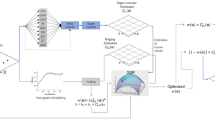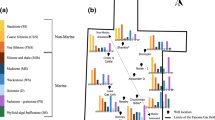Abstract
Building a geological model is important in resource estimation, as it defines the extent of domains for estimation. Geological models are built by assigning a domain to the samples, based on logging of different features related to lithology, alteration, and mineralization. Then, the extent of these domains is determined using geometric or geostatistical tools. However, these models should account for uncertainty, since the actual extent of these domains is not known and must be extrapolated from the labelled samples. With the availability of geochemical datasets and machine learning techniques, employing multiple variables to build resource models should be considered. This article proposes a two-step machine learning approach with an ensemble implementation to define geological domains and their uncertainties. First, an unsupervised binary clustering method labels the geochemical samples into two domains. These labelled samples are used to inform a geological domain model built by support vector classification. This application is repeated with subsets of variables and subsets of samples, leading to an ensemble learning method. Weak models are produced with each subset of samples and variables, and combined to devise a stronger learner. The final model accounts for uncertainties thanks to the ensemble implementation. The proposed workflow is demonstrated on a dataset from a porphyry copper deposit, applied hierarchically to define four domains. Performance is comparable with traditional methods, but provides the advantage of allowing domain knowledge in the selection of the variables, and generates domain boundaries that can be controlled in terms of their continuity and smoothness.

















Similar content being viewed by others
Data Availability
Not applicable.
Code Availability
Not applicable.
References
Abzalov M (2016) Applied mining geology. Springer. https://doi.org/10.1007/978-3-319-39264-6
Armstrong M, Galli A, Beucher H, Loc’h G, Renard D, Doligez B, Eschard R, Geffroy F (2011) Plurigaussian simulations in geosciences. Springer. https://doi.org/10.1007/978-3-642-19607-2
Cevik IS, Olivo GR, Ortiz JM (2021) A combined multivariate approach analyzing geochemical data for knowledge discovery: the Vazante – Paracatu Zinc District, Minas Gerais, Brazil. J Geochem Explor 221:106696. https://doi.org/10.1016/j.gexplo.2020.106696
Deutsch CV (2006) A sequential indicator simulation program for categorical variables with point and block data: BlockSIS. Comput Geosci 32:1669–1681. https://doi.org/10.1016/j.cageo.2006.03.005
Duke JH, Hanna PJ (2001) Geological interpretation for resource modelling and estimation, in mineral resource and ore reserve estimation. Monogr Ser - Aust Inst Min Metall 23:147–156
Dumakor-Dupey NK, Arya S (2021) Machine learning—a review of applications in mineral resource estimation. Energies, Basel 14:4079. https://doi.org/10.3390/en14144079
Emery X, Ortiz JM (2005) Estimation of mineral resources using grade domains : critical analysis and a suggested methodology. J South Afr Inst Min Metall 105:247–256
Faraj F, Ortiz JM (2021) A simple unsupervised classification workflow for defining geological domains using multivariate data. Min Metall Explor 38:1609–1623. https://doi.org/10.1007/s42461-021-00428-5
Galli A, Beucher H, le Loc’h G, Doligez B, Group H (1994) The pros and cons of the truncated Gaussian method. In: Armstrong M, Dowd PA (eds) Geostatistical simulations, quantitative geology and geostatistics, vol 7. Springer, Dordrecht, pp 217–233. https://doi.org/10.1007/978-94-015-8267-4_18
Gutierrez R, Ortiz JM (2019) Sequential indicator simulation with locally varying anisotropy – simulating mineralized units in a porphyry copper deposit. J Min Eng Res 1:1–7. https://doi.org/10.35624/jminer2019.01.01
Harris D, Pan G (1999) Mineral favorability mapping: a comparison of artificial neural networks, logistic regression, and discriminant analysis. Nat Resour Res 8:93–109. https://doi.org/10.1023/A:1021886501912
Hastie T, Tibshirani R, Friedman J (2009) Overview of supervised learning. In: The elements of statistical learning. Springer Series in Statistics. Springer, New York, NY. https://doi.org/10.1007/978-0-387-84858-7_2
Hestenes MR, Stiefel E (1952) Methods of conjugate gradients for solving linear systems. J Res Natl Bur Stand 49:409
Journel AG (1980) The lognormal approach to predicting local distributions of selective mining unit grades. Math Geol 12:285–303. https://doi.org/10.1007/BF01029417
Le Vaillant M, Hill J, Barnes SJ (2017) Simplifying drill-hole domains for 3D geochemical modelling: an example from the Kevitsa Ni-Cu-(PGE) deposit. Ore Geol Rev 90:388–398. https://doi.org/10.1016/j.oregeorev.2017.05.020
Mariethoz G, Caers J (2014) Multiple-point geostatistics: stochastic modeling with training images. Wiley-Blackwell
Moreira GD, Coimbra Leite Costa JF, Marques DM (2020) Defining geologic domains using cluster analysis and indicator correlograms: a phosphate-titanium case study. Appl Earth Sci 129:176–190. https://doi.org/10.1080/25726838.2020.1814483
Ortiz J, Emery X (2006) Geostatistical estimation of mineral resources with soft geological boundaries: a comparative study. J South Afr Inst Min Metall 106:577–584
Romary T, Rivoirard J, Deraisme J, Quinones C, Freulon X (2012) Domaining by clustering multivariate geostatistical data. In: Abrahamsen P, Hauge R, Kolbjørnsen O (eds) Geostatistics Oslo 2012. Quantitative geology and geostatistics, vol 17. Springer, Dordrecht. https://doi.org/10.1007/978-94-007-4153-9_37
Rossi ME, Deutsch CV (2014) Mineral resource estimation. Springer, Netherlands. https://doi.org/10.1007/978-1-4020-5717-5
Sepúlveda E, Dowd PA, Xu C (2018) Fuzzy clustering with spatial correction and its application to geometallurgical domaining. Math Geosci 50:895–928. https://doi.org/10.1007/s11004-018-9751-0
Sillitoe RH (2010) Porphyry copper systems. Econ Geol 105:3–41. https://doi.org/10.2113/gsecongeo.105.1.3
Sterk R, de Jong K, Partington G, Kerkvliet S, van de Ven M (2019) Domaining in mineral resource estimation: a stock-take of 2019 common practice. In Proceedings of the 11th International Mining Geology Conference, Perth
Tutmez B (2019) Lithological classification of cement quarry using discriminant algorithms. J Cent South Univ 26:719–727. https://doi.org/10.1007/s11771-019-4042-6
Velasquez H, Aguilar M (2020) Rock type classification for the determination of estimation domains in a Cu-Zn skarn deposit in Central Peru, new approach using Gaussian kernel support vector machine. Int J Sci Technol Res 9
Funding
Kasimcan Koruk received funding from the Ministry of National Education Turkey through a scholarship for the MASc program. Dr. Ortiz acknowledges the funding provided by the Natural Sciences and Engineering Council of Canada (NSERC) grant number RGPIN-2017-04200 and RGPAS-2017-507956.
Author information
Authors and Affiliations
Corresponding author
Ethics declarations
Competing Interests
The authors declare no competing interests.
Additional information
Publisher’s Note
Springer Nature remains neutral with regard to jurisdictional claims in published maps and institutional affiliations.
Rights and permissions
Springer Nature or its licensor (e.g. a society or other partner) holds exclusive rights to this article under a publishing agreement with the author(s) or other rightsholder(s); author self-archiving of the accepted manuscript version of this article is solely governed by the terms of such publishing agreement and applicable law.
About this article
Cite this article
Koruk, K., Ortiz, J.M. Geological Domaining with Unsupervised Clustering and Ensemble Support Vector Classification. Mining, Metallurgy & Exploration 40, 2537–2549 (2023). https://doi.org/10.1007/s42461-023-00858-3
Received:
Accepted:
Published:
Issue Date:
DOI: https://doi.org/10.1007/s42461-023-00858-3




